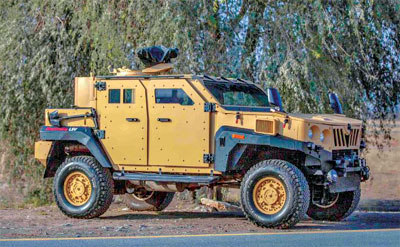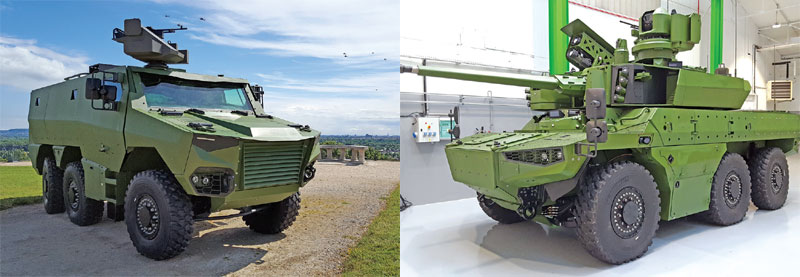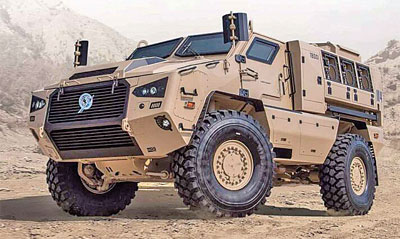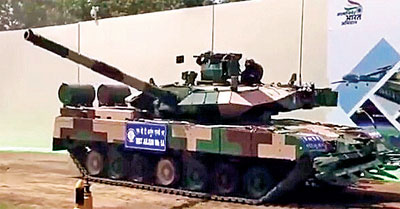As the Chinese threat looms, Indian Army seeks a range of multiutility vehicles
Smruti D
With the stand-off in Ladakh showing no signs of abating, government of India authorised emergency procurement of several types of weapons and equipment to strengthen Indian positions all along the Line of Actual Control (LAC) last year. Top on the list were vehicles—for quick and secure transportation and fighting.

Sensing an opportunity, Russia offered India its 18-tonne Sprut SDMI lightweight tanks. The offer was made to the defence minister Rajnath Singh during his visit to Russia in June 2020. As of now, the matter hangs there, with India still evaluating the offer. Meanwhile, after China deployed Type 15 light tanks in the area in August 2020, India had to rely upon what it had—the heavier battle tanks. Also, under emergency purchase, Indian Army directly placed the order for M4 armoured vehicles with Bharat Forge in February 2021.
In the last few years, Indian defence purchases have become crises-driven instead of long-term capability building. When tensions between India and Pakistan heightened two years ago, the government announced the buying of 198 armoured personnel carriers (AFV) for the Indian Army. These, they said, would replace the Soviet Origin BRDM combat reconnaissance patrol vehicles. Several deals followed this, and a number of Indian private sector companies bagged orders for manufacturing of military vehicles needed by the Indian armed and paramilitary forces catering to different war zones and terrains.
While IED remains the main threat in LWE, J&K is also seeing a gradual increase in the usage of this deadly tactic by the adversaries. A per a newspaper report, intelligence officials and forensic experts in 2019, ‘warned of more Pulwama-style improvised explosive device (IED) attacks on personnel in J&K,’ in which a suicide bomber attacked the CRPF’s convoy, killing 40. India remains one of the highest IED-affected countries around the globe.
Given this, the requirement of military vehicles, both for transportation and fighting has increased. In fact, the trend worldwide is for multi-utility vehicles that provide all three: safety, mobility and fighting capability. In India, however, we still have a neat distinction between different kind of military vehicles and their uses.
Transport Vehicles
Armoured personnel carriers are used to transport troops in combat zones. These vehicles, depending upon the terrain can be wheeled or tracked. Armoured personnel vehicles are not used in direct combat (though some have defensive capabilities), unlike infantry fighting vehicles which provide direct fire support to the troops.
With the increase in sub-conventional warfare often conducted in semi-urban/ urban and inhabited places, militaries around the world are relying heavily on military vehicles. Consequently, original equipment manufacturers (OEMs) have been investing in these vehicles. For lightweight bullet-proof armour, Honeywell has come up with bullet-proof fibre and ballistic composite materials such as Spectra Shied, Gold Shield and Gold Flex. These light-weight materials are used for armouring of vehicles apart from helmets, vests and plates.
Newspaper reports in December 2020 stated that the CRPF would soon induct the Sherpa Light all-terrain vehicle. It is a 4×4 tactical and light armoured vehicle designed by Renault Trucks Defense, France. Sherpa, despite its armoury, offers high mobility. It can be used for tactical purposes such as patrol, convoy escort, command and liaison. The Sherpa Light can accommodate four personnel who can fire from inside the vehicle. It is fitted with a camera and can sustain a blast of up to 10kg RDX. Sherpa was recently spotted on the roads of Kashmir. The CRPF started using the MPVs only after the 2016 militant attack that claimed lives of eight personnel. Sherpa was deployed in Kashmir in 2018, and later in November and December 2020. This vehicle is already in use with National Security Guards (NSG) and Central Industrial Security Force (CISF).
MPVs or Mine-Resistant Ambush-Protected (MRAP) vehicles, even though they provide protection from low-grade blasts, often cause grave spinal injuries to the personnel sitting inside as the vehicle experiences severe shock and gets thrown in the air. For this reason, the CRPF had halted the use of MPVs made by the Ordnance Factories Board (OFB) as they could not withstand the IED blasts in LWE areas. The director general, CRPF in 2011, K Vijaykumar described these vehicles as ‘coffins on wheels.’ However, despite the criticism, he maintained that these vehicles were useful in troop transportation and provided protection from ballistic ambushes. While these vehicles came to be banned for usage for some time, they were allowed into service later.
In June 2020, the US military awarded a contract to Polaris Inc. to build new ultralight tactical vehicle, the MRZR Alpha. The vehicle delivers superior off-road manoeuvrability and performance for special operations. The latest model within the Alpha MRZR light tactical vehicles family is already in service with the US forces. This vehicle can be used for infantry mobility, indirect fire, explosive ordnance disposal (EOD), command and control, logistics and missile launch missions.

Thales is also delivering one of the new-generation light and protected vehicles. Hawkei, a seven-tonne, 4×4 protected vehicle is designed to provide protection, mobility and payload with blast and ballistic protection. Hawkei can incorporate future system requirements of adaptive campaigning with C4I (command, control, communications, computers and intelligence). This vehicle is transportable by air; and has often been ferried in C-130 Hercules. The vehicle is suited to be used in troop movement, command and control, electronic warfare, liaison, surveillance and reconnaissance missions. Originally built by Thales for the Australian Defence Force (ADF), Hawkei can accommodate four to six soldiers at a time, including the driver.
Meanwhile, India’s TATA and DRDO have jointly developed WhAP, also known as Kestrel, which is being described as a modern armoured personnel carrier. The Kestrel is an eight-wheeled amphibious armoured personnel carrier which can run at a speed of 100km per hour on road and 10km per hour on water.
Mahindra Defence, through MEVA Straton and MEVA Straton Plus offers a ‘wide-range of light armoured personnel carriers, light armoured vehicles and mine-resistant ambush protected vehicle’. While the former comprises armoured personnel carriers (APC), Straton Plus is offered in Light Armoured Vehicle (LAV) and Light Tactical Vehicle (LTV) configurations. Mine Protected Vehicle-I (MPV) is a MRAP-type armoured personnel carrier and a specialist off-road vehicle. Mahindra Marksman and MEVA Armoured Specialist Vehicle (ASV) are two other vehicles that the company is offering. With no clear distinction between the roles they perform, these vehicles can be used as multirole vehicles which can be deployed in different situations.
Another Indian company, Ashok Leyland in April delivered its ‘Light Bullet Proof Vehicles’ (LBPV) to the Indian Air Force. This vehicle is an adapted version of Common Vehicle Next-Gen (CVNG) by Lockheed Martin. Ashok Leyland produced the vehicle in country upon Transfer of Technology (ToT) from Lockheed Martin. Ashok Leyland is involved in manufacturing of a number of military vehicles that range from 4×4 to 12×12. The LBPV can operate in mud, sand, rocks and shallow waters. The vehicle has ‘extremely high payload fraction’ and can accommodate six crew members and offers ‘ample cargo space’. The vehicle offers protection from ballistic and blast threats.
In 2018, Ashok Leyland signed an MoU with Israel’s Elbit Systems to provide High Mobility Vehicles (HMV), the product of which was going to be offered to global export markets. The same year, the company bagged a tender to supply tracked combat vehicles for the Indian armed forces. The manufacturing for this was to be done in collaboration with Combat Vehicles Research Development Establishment (CVRDE), Chennai.
In 2012, the company unveiled the COLT 4×4 Light Tactical Vehicle (LTV) developed and produced in partnership with the French company, Panhard General Defense. This vehicle has three variants—COLT Light Tactical Vehicle (4×4), COLT Airmobile and COLT Light Armoured Vehicle (LAV). Super Stallion, an 8×8 High Mobility Vehicle (HMV) is another logistics-based vehicle by the company. Concord 8 (C8) is a lightweight rugged armoured vehicle developed by Ashok Leyland. The company had also bagged a Rs 100 crore tender to supply 81 high mobility 10×10 vehicles to the army. These vehicles would replace the existing Russian vehicles that carried Smerch launchers. This tender was floated by the army in 2015 in order to reduce imports. The 10×10 vehicle can carry a maximum load of 27 tonnes at a maximum speed of 60kmph. Some of these vehicles will be fitted with rocket handling cranes.
As a much-needed boost to India private defence players, after the contract to Mahindra and Bharat Forge, it is being said that TATA too may get an order from the army soon. According to media reports, in August 2020, TATA’s Kestrel was contending with American vehicles, Humvee and Stryker, for the Indian Army’s requirement of heavy armoured infantry vehicles for ‘quick movement of troops in Eastern Ladakh’.

Transport-Cum-Fighting Vehicles
The Indian Army recently placed an order with Mahindra Defence Systems worth Rs 1,056 crore for 1,300 Armoured Light Specialist Vehicles (ALSV) to be delivered in four years. In a press statement, the ministry of defence said, ‘The induction of vehicles is planned to be completed in four years. The Light Specialist Vehicle is a modern fighting vehicle and will be authorised to various fighting units for carriage of Medium Machine Guns, Automatic Grenade Launchers as well as Anti-tank Guided Missiles.’ These combat vehicles come with an all-round protection against small arms fire and will assist independent detachments which are required to operate the weapon platform. This project will be undertaken entirely indigenously.
The ALSV has ballistic protection up to B7, STANAG Level II against IEDs, hand grenades and anti-personnel mines. The 4×4 system on the ALSV can carry a payload of 1,000 kg and is sprung on a high travel all-wheel independent suspension with central inflation system. The vehicle can be fitted with a self-recovery winch. It has a self-cleaning exhaust scavenging and air filtration system, which makes it easier to travel in deserts. The vehicle can be equipped with in-service GPS and an automatic grenade launcher or medium machine gun.
These vehicles come in different variants, such as 6 to 8-seater Armoured Protection Vehicle for Security; Light Armoured Ambulance; Command and Control Vehicle, Light Mortar 81/82mm Vehicle and Ammunition Carrier for Light Weapons.
The Indian Army has also placed an order for 156 Sarath BMP-II Infantry Combat Vehicles, valued at nearly Rs 1,100 crore, after the MoD cleared the proposal in June 2020. Of Soviet origin, Sarath BMP-II, being manufactured in India by OFB, are basically an upgradation of the BMP-II with new command & control systems and Kornet E anti-tank missiles along with third-generation night-vision capability.
Also part of the upgrade will be a new technology termed as ‘see-through armour’ developed by a Bangalore-based start-up, Tonbo Imaging. This will give the commander, his driver and the gunman a 360-degree view even at night. Apparently, this would address the problem of the driver’s vision getting hampered due to smoke, dust, fog and darkness. The start-up would use cameras and magnetic trackers as solution. Two other start-ups are also said to be collaborating with the OFB.
Additionally, Sarath BMP-II, which is an amphibious vehicle, will have 300 HP engine and the speed of 65km per hour on ground and 7km per hour on water. Equipped with 7.62mm medium coaxial machine gun, 30mm cannon and a second-generation anti-tank guided missile, the vehicle will also have low silhouette.
The ambitious Futuristic Infantry Combat Vehicle (FICV) has for now taken a backseat. Since, the Mark I of the 12-year-old programme didn’t fructify, Indian Army floated the idea of a Mark II advanced vehicle. The army chief Gen. M.M. Naravane is reported to have said that the army is making efforts to acquire these vehicles by 2026-2027. Tata, Mahindra, Reliance and L&T are some of the private industries that are keen on participating in this programme. However, some reports also say that with the placing of the Sarath order, even Mark II may be shelved.

In 2018, the Indian Army extended an order to Force Motors for the supply of Light Strike Vehicles. The Light Strike Vehicle designed and developed by the research and development team at Force Motors is fully indigenous. The vehicle was tested in the trials conducted for over two years in terrains as varied as Rajasthan (50 degree C) and Ladakh (-30 degree C). These vehicles, designed for quick ingress and egress have high manoeuvrability, speed and stability. The configuration of these vehicles is 4×4. It has the provision to mount a rocket launcher and machine guns. They can also be airlifted.
As mentioned earlier, the Indian Army has also placed an order worth Rs 177.95 crore for the M4 armoured vehicles as emergency purchase. These vehicles underwent trials in Ladakh in August 2020. The number vehicles to be procured has not been mentioned by either the MoD or the company. However, in a press note, Bharat Forge had said that the initial order would be of a smaller number and that the army may consider procuring more of these. This multirole vehicle can also be used in terrains that may have threats from IEDs and landmines as it is equipped with ballistic and blast protection up to 50kg TNT. The vehicle has a thrust speed of 140km per hour, payload of 2.3 tonnes and a range of about 800km. It can carry a crew of six and a driver. Bharat Forge has entered a deal with South Africa’s Paramount Group, the original maker of the M4 armoured vehicle. The M4 will replace the BMRD-2 wheeled armoured personnel carriers (APCs).
Globally, the trend in military vehicles has been to combine armoured infantry carriers with fighting capabilities. In 2016, the French Army and DGA unveiled its ambitious Scorpion programme, under which it also aimed to build two new military vehicles. Griffon (armoured personnel carrier) and Jaguar (light multi-purpose armoured vehicle) are being developed by a consortium of French companies, comprising Nexter Systems, Renault Trucks Defense and Thales. Griffon can be used for troop transport, command post, artillery observation, recovery, refuelling, and medical evacuation. The French armed forces plan to acquire 1,688 of these vehicles under the Scorpion programme. A Griffon VBMR prototype was introduced at Eurosatory 2016. Griffon is manned by a crew of two and can accommodate maximum of eight personnel. The deliveries of Griffon will be complete by 2033.
Jaguar combat vehicle, built on a chassis of 6×6 weighs about 25 tonnes. A total of 248 vehicles will be built and deliveries will complete in 2032. This vehicle will have the same mobility system as Griffon. It will be capable of operating at a speed of 90 kmph with the range of 800 km and can carry three crew members with two in the turret. The vehicle will carry 40 mm CTAS gun and MBDA’s MMP missiles.
Last December, Nexter delivered first four regenerated armoured infantry fighting vehicles to the French Army. The VBCI was designed to replace the old tracked armoured infantry fighting vehicle AMX-10P that was used by infantry mechanised units of the French Army. The wheeled infantry vehicle of 8×8 provides modular protection that can be adapted to any threat situation. With the gunner of this vehicle seated in the turret, it can reach a speed of over 100kmph and has an unrefuelled range of 750 km. The vehicle can run on roads as well as railway gauge and can be air transported.

Tanks
Earlier this year, the Defence Acquisition Council (DAC) approved the procurement of 118 Arjun Mk-1A ‘Hunter Killers’, developed by the DRDO. The new battle tank is an upgraded version of the Arjun Mk-1, which is currently in use with the army. The new version will have 14 major upgrades which are intended to enhance its survivability, mobility and lethality. These includes ‘firepower, advanced land navigation systems and improved night-vision capabilities, advanced laser warning, countermeasure systems and containerised ammunition bin’.
Despite the emergence of disruptive technologies, the land forces still rely on tanks. For instance, even the French Scorpion programme which seeks a modernised army by 2033, has space for a tank. The Nexter-made Leclerc MBT has been converted into Leclerc Scorpion or XLR. According to Military Recognition: “In March 2015, the French Army Defence Procurement Agency (DGA) notified Nexter Systems a renovation contract for the Leclerc MBT. This order constitutes the third operation launched by the French Ministry of Defence under the SCORPION program intended to modernize the French Army’s contact forces. Valued at approximately Euro330 million, the contract provides for the delivery of 200 ‘Renovated Leclerc’ tanks and 18 ‘Renovated DCL’ armoured recovery vehicles based on Leclerc MBT from 2020.”
Meanwhile, Russia has pitched its T-14 Armata tanks as one of the best. According to GlobalSecurity.org, the Armata Universal Combat Platform is a unified heavy platform created for a variety of armoured vehicles, including the main battle tank, infantry fighting vehicles, armoured personnel carriers, among others. The T-14 Armata has fully digitized equipment, an unmanned turret, and an isolated armoured capsule for the crew. The tank can intercept and destroy incoming missiles and rockets using its Active Protection System (APS) feature.
With unresolved border disputes and territorial aggression, the military vehicles are having a field day.

